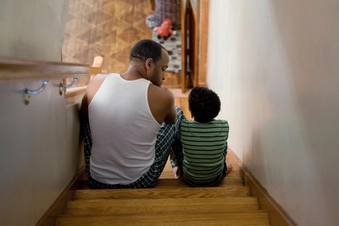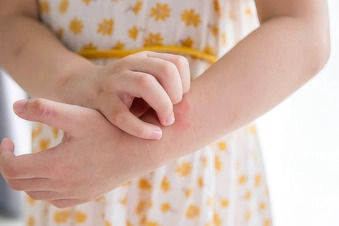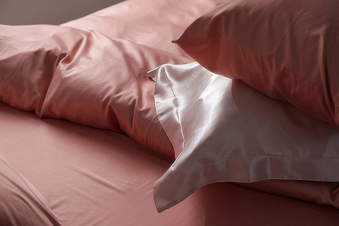Help Your Child With Atopic Dermatitis Manage Their Mental Health

Focus on Sleep
Well over half of children who have atopic dermatitis, aka eczema, have trouble sleeping. This includes having a hard time getting to sleep and waking up in the morning, and waking during the night. It can become worse during AD flares. A lack of good rest can make kids feel drowsy, moody, and absent-minded during the day.

Improve Sleep Hygiene
To help your child get a restful night’s sleep:
- Create a dark, cool, quiet sleep environment. Don’t use the sleep area for playtime or anything else.
- Banish electronic screens.
- Apply moisturizers as advised by your child’s health care provider.
- Make a pleasant bedtime routine for you and your child. This might include brushing teeth, reading a story, or having a mini talk session.
- Make sure your child has been active enough to be tired.

Help Your Child Open Up
Research has found links between children as young as 4 years old who have AD and internalizing behavior. This means their feelings and actions are expressed inwardly. This can take the form of depression, anxiety, and sleeplessness. Help your child ID and express their feelings by taking time to ask them how they’re doing. If they seem sad or frustrated, invite them to talk about it.

Break It Down in Simple Terms
It’ll be easier for your child to learn about and live with their AD if they understand it. From finding age-appropriate books and videos – a simple internet search will turn up many titles – to demo-ing product use, you can help your child better grasp why their skin needs the extra care it does.

Turn ‘Can’t Do’ Into ‘Can Do’
Try to frame negative language – like “Stop scratching” – in a more positive light. For example, you might say something like this instead: “I can tell your eczema is acting up,” and then brainstorm together on how to soothe it. This reminds them that AD isn’t their fault, plus it gives them tools to control the AD and feel better about it.

Look Into a 504 Plan
If your child’s AD is severe or poses problems at school, ask about a 504 plan. It falls under a federal act that says schools must help students perform to the best of their ability. Many children have 504 plans for a wide range of issues. Your child’s plan might provide, for example, that they can use a computer for schoolwork instead of printouts and pencils if their AD affects their hands.

Help Kids Share About AD
Make it easy for your child to field questions and comments about their AD. Though they don’t have to answer, it can help to have ideas about what to say to curious peers. Your child might respond, for example, “It’s called atopic dermatitis (or eczema). It makes your skin itchy and dry, but other people can’t catch it.” Practice with role play.

Check Into Therapy
Children can feel relieved and reassured when they have a place to share about their AD. Counseling can show that their feelings are normal. They can learn ways to relax, calm their minds, and soothe symptoms. Older children can learn to manage their own AD and feel more in control and confident as they navigate relationships and forge their own identity.

Finding a Therapist
Ask your child’s provider for a referral. If you can’t find one who specializes in AD, look for a therapist who works with children with chronic health conditions. If this isn’t possible, prepare info about AD for them to review. Also, sometimes insurance plans that don’t cover mental health will cover therapy for AD support.

Pamper Pre-Teens
Adolescents love to primp. Some tips for joining the spa set:
- Reusable cooling masks and ice globes – cold-roller facial tools – can calm riled skin. And kids can look cool doing it.
- Silk pillowcases are pure luxury. They’re also hypoallergenic, and the fabric won’t catch on or rub skin.
- Sidestep facial scrubs. If your child doesn’t have AD on their face or neck, a gentle face steam can be OK. Just have them moisturize afterward.

Mind Your Own Mental Health
Mothers of children with AD have twice the depression rate as moms of children with asthma, according to a clinical report. Fatigue, lack of sleep, anxiety, and financial worries because of AD can take a mental toll on parents and caregivers alike. Know that there are lots of support groups, counseling, and other resources to tap into. The National Eczema Association is a good place to start.

Break Out Stress-Busting Tools
It’s helpful to have de-stressing techniques up your sleeve. Share these tools with your child, then compare:
- Download guided meditation apps to demo.
- Maintain a zen-vironment with peaceful nature sounds or relaxing music.
- Take time to read, play with a pet, or take a nature walk.
- Keep your hands busy and your mind on “flow” with painting, kits, knitting, gaming, etc.
Show Sources
IMAGES PROVIDED BY:
- DigitalVision/Getty Images
- iStock/Getty Images
- Stone/Getty Images
- E+/Getty Images
- iStock/Getty Images
- E+/Getty Images
- E+/Getty Images
- E+/Getty Images
- E+/Getty Images
- iStock/Getty Images
- iStock/Getty Images
- E+/Getty Images
SOURCES:
American Academy of Pediatrics: “Burden of Atopic Dermatitis, “Healthy Sleep for Atopic Dermatitis.”
National Eczema Association: “Eczema and Mental Health in Children,” “Helping Your Child Cope With Eczema,” “Helping Your Child Cope With Eczema at School,” “Ask the Ecz-perts: Mental Health and Children With Eczema,” “Eczema and Emotional Wellness.”
Jama Dermatology: “Association of Atopic Dermatitis and Mental Health Outcomes Across Childhood: A Longitudinal Cohort Study.”
Pediatrics: “Atopic Dermatitis: Skin-Directed Management.”